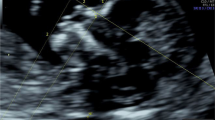Abstract
Objective
The cheek-to-cheek diameter (CCD) has been shown to be an indicator of subcutaneous tissue mass in the fetus. However, the correlation between CCD and the abdominal circumference (AC) has not been investigated yet. The objective of the present study was to demonstrate whether a correlation exists between fetal CCD, AC, estimated fetal weight (EFW), and the 1 h, 50 g, glucose challenge test (GCT) levels in patients with and without gestational diabetes mellitus.
Methods
A prospective, institutional review board approved study was performed. The CCD was obtained as part of the ultrasound for obstetric interval growth scans and biophysical profiles. Exams were performed during the third trimester. The CCD was obtained on a coronal view of the fetal face, at the level of the nostrils and lips. Patients were enrolled between November 2005 and May 2006. Pearson correlation coefficient and linear regression modeling were used as appropriate.
Results
Eighty-three patients were enrolled, 29 (33%) of them were diabetic. The mean gestational age is 34.8 ± 3 weeks and the mean maternal age is 29.9 ± 5.1. A significant linear association was found between CCD and EFW (Pearson coefficient of correlation being 0.51, P = 0.01). The Pearson correlation coefficient of the relationship between the CCD and AC was 0.47 (P = 0.01). Using a linear regression model, controlling for gestational age at performance of the ultrasound, the association between CCD and EFW remained significant (P = 0.021). There were no significant differences between diabetic and non-diabetic patients regarding the CCD (6.2 ± 0.9 vs. 6.3 ± 0.9 respectively, P = 0.669) or the EFW (2,527.9 ± 705 vs. 2,645 ± 760 g). While AC was significantly correlated with the GCT levels (Pearson coefficient of correlation = 0.46, P = 0.024), no such correlation was demonstrated for CCD (Pearson correlation coefficient = 0.23, P = 0.160).
Conclusions
The cheek-to-cheek diameter is significantly correlated to the abdominal circumference and the estimated fetal weight. However, the abdominal circumference has a tighter correlation with the glucose challenge test.






Similar content being viewed by others
References
Abramowicz JS, Sherer DM, Bar-Tov E, Woods JR Jr (1991) The cheek-to-cheek diameter in the ultrasonographic assessment of fetal growth. Am J Obstet Gynecol 165(4 Pt 1):846–852
Warsof SL, Gohari P, Berkowitz RL, Hobbins JC (1977) The estimation of fetal weight by computer-assisted analysis. Am J Obstetric Gynecol 128:881–892
Farrell T, Fraser R, Chan K (2004) Ultrasonic fetal weight estimation in women with pregnancy complicated by diabetes. Acta Obstet Gynecol Scand 83(11):1065–1066
Stotland NE, Caughey AB, Breed EM, Escobar GJ (2004) Risk factors and obstetric complications associated with macrosomia. Int J Gynaecol Obstet 87(3):220–226
Wong SF, Chan FY, Cincotta RB, Oats JJ, McIntyre HD (2001) Sonographic estimation of fetal weight in macrosomic fetuses: diabetic versus non-diabetic pregnancies. Aust NZ Obstetric Gynaecol 41:429–432
Abramowicz JS, Rana S, Abramowicz S (2005) Fetal cheek-to-cheek diameter in the prediction of mode of delivery. Am J Obstet Gynecol 192(4):1205–1211
Abramowicz JS, Robischon K, Cox C (1997) Incorporating sonographic cheek-to-cheek diameter, biparietal diameter, abdominal circumference improves weight estimation in the macrosomic fetus. Ultrason Obstetric Gynecol 9(6):409–413
Hadlock FP, Harrist RB, Sharman RS, Deter RL, Park SK (1985) Estimation of fetal weight with the use of head, body and femur measurements-a retrospective study. Am J Obstet Gynecol 151:333–337
Abramowicz JS, Sherer DM, Woods JR Jr (1993) Ultrasonographic measurement of cheek-to-cheek diameter in fetal growth disturbances. Am J Obstet Gynecol 169(2):405–408
Larciprete G, Valensise H, Vasapollo B, Novelli GP, Parretti E, Altomare F, Di Pierro G, Menghini S, Barbati G, Mello G, Arduini D (2003) Fetal subcutaneous tissue thickness (SCTT) in healthy and gestational diabetic pregnancies. Ultrasound Obstet Gynecol 22(6):591–597
Bernstein IM, Catalano PM (1994) Examination of factors contributing to the risk of cesarean delivery in women with gestational diabetes. Obstet Gynecol 83(3):462–465
Kehl RJ, Krew MA, Thomas A, Catalano PM (1996) Fetal growth and body composition in infants of women with diabetes mellitus during pregnancy. J Matern Fetal Med 5:273–280
Conflict of interest statement
None.
Author information
Authors and Affiliations
Corresponding author
Rights and permissions
About this article
Cite this article
Kerrick, H., Sheiner, E., Mandell, C. et al. The fetal cheek-to-cheek diameter and abdominal circumference: are they correlated?. Arch Gynecol Obstet 280, 585–588 (2009). https://doi.org/10.1007/s00404-008-0924-9
Received:
Accepted:
Published:
Issue Date:
DOI: https://doi.org/10.1007/s00404-008-0924-9




